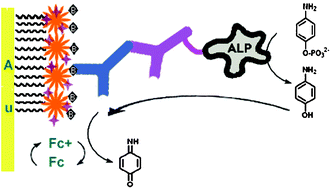An electrochemical immunosensor using ferrocenyl-tethered dendrimer
Abstract
We report here an enzyme-amplified, sandwich-type immunosensor for detecting the biospecific interaction between an antibody and

* Corresponding authors
a
Department of Chemistry, Korea Advanced Institute of Science and Technology (KAIST), Daejeon, Korea
E-mail:
Juhyoun_Kwak@kaist.ac.kr
Fax: +82 42 869 2810
Tel: +82 42 869 2833
b
Department of Chemistry and Center for Innovative Bio-physio Sensor Technology, Pusan National University, Busan, Korea
E-mail:
hyang@pusan.ac.kr
We report here an enzyme-amplified, sandwich-type immunosensor for detecting the biospecific interaction between an antibody and

 Please wait while we load your content...
Something went wrong. Try again?
Please wait while we load your content...
Something went wrong. Try again?
S. J. Kwon, E. Kim, H. Yang and J. Kwak, Analyst, 2006, 131, 402 DOI: 10.1039/B509969B
To request permission to reproduce material from this article, please go to the Copyright Clearance Center request page.
If you are an author contributing to an RSC publication, you do not need to request permission provided correct acknowledgement is given.
If you are the author of this article, you do not need to request permission to reproduce figures and diagrams provided correct acknowledgement is given. If you want to reproduce the whole article in a third-party publication (excluding your thesis/dissertation for which permission is not required) please go to the Copyright Clearance Center request page.
Read more about how to correctly acknowledge RSC content.
 Fetching data from CrossRef.
Fetching data from CrossRef.
This may take some time to load.
Loading related content
